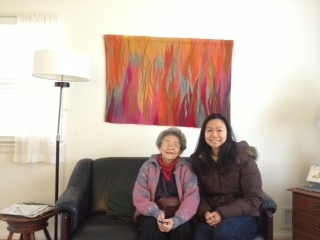“Conducting Oral History” by Chrissy Yee Lau

Takemoto and Lau
As a Goldman Sachs Multicultural Junior Fellow at the National Museum of American History, I have access to many resources to build upon my doctoral research. My research focuses on Japanese American middle-class culture during the 1920s and 1930s in southern California. One of my dissertation chapters examines the piano as a cultural totem for the Japanese American community. My advisor, Noriko Sanefuji, connected me with Mrs. Alice Takemoto, a young Japanese American piano prodigy at the early age of seven during the 1930s in Orange County. On Friday, March 1, Noriko and I took the metro to the suburbs of DC and Mrs. Takemoto was kind enough to pick us up from the metro and invite us into her home. As an 86 year old Nisei, she was a cute elderly lady who was very open to sharing her story. I was very interested in her early years prior to the war.
During the interview, Mrs. Takemoto said that her father had made it a priority that his three daughters would learn how to play music, including the cello and the piano. At three years old, one day she accompanied her mother and sister as her sister was receiving a piano lesson. She listened to her sister playing but said aloud to her mother that her sister was playing in the wrong key. Her mother was intrigued by her distinction and they soon found out that their little three year old had perfect pitch. Mrs. Takemoto began taking lessons but the piano came very easy to her even when she did not practice. She began performing in public for churches at the age of seven. One month, she played over thirty performances. Her mother hand-sewed beautiful dresses for her to wear at public performances.
After Executive Order 9066, Mrs. Takemoto stopped playing the piano because her family had to move to the Santa Anita race track, where Japanese Americans were gathered temporarily to be moved to more permanent camps. Luckily, Mrs. Takemoto’s sisters arranged to keep the piano in a basement of a Quaker church. She spent her highschool years in an internment camp, then left to attend Oberlin College, and moved to DC where she stayed for over forty years. Her childhood piano still remains within her family, passed down to her niece. To this day, Mrs. Takemoto still performs concerts from within her own home.
After listening to Mrs. Takemoto’s story, I cannot wait to add her interview into my dissertation. Her oral history will be a big contribution to a history of the piano in Japanese American culture. I am excited to see what other possibilities there will be for me to continue doing my research here with the NMAH at the Smithsonian.






